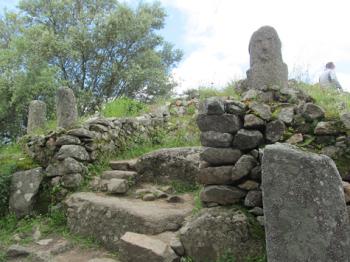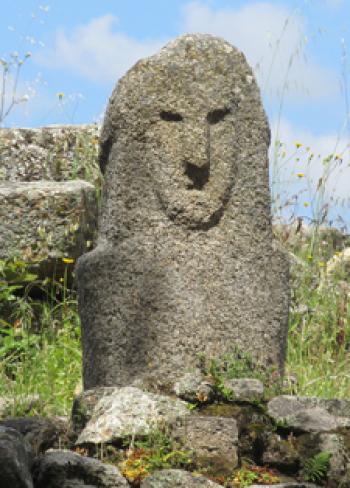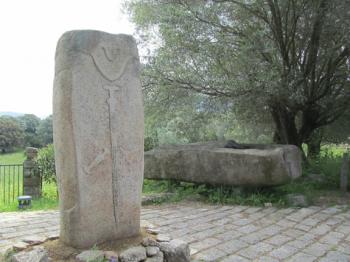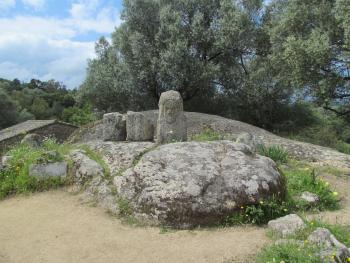Prehistoric sentinels of Corsica
This item appears on page 49 of the February 2019 issue.
At the base of a small mound overlooking a valley in southwestern Corsica lie fragments of upright stones called menhirs (from the Brittonic words men, meaning "stone," and hir, meaning "long").
Just above them on a stone wall that was once part of a prehistoric settlement stand more menhirs. They are unique. Each has the outline of a face etched on the top part of the stone. With sightless eyes, these statue-menhirs have stood for more than 3,000 years. They are simple and hauntingly beautiful.
Corsica's history
Ancient as these menhirs are, the history of Corsica and of this site, Filitosa, stretches much further back in time. Corsica is the fourth-largest island in the Mediterranean, lying southeast of mainland France. Humans have lived there for at least 10,000 years.
It is thought that in the early Neolithic period, between 5000 and 6000 BC, migrants from mainland Italy arrived, living in the abundant rock shelters while hunting, fishing and gathering. By about 3500 BC, the land was being farmed and cattle were being raised. This is also the time when the first menhirs were fashioned.
Early menhirs were simply standing stones, often crudely worked. Over succeeding centuries these evolved into more carefully worked stones, some of which bear distinct and unique facial and body features like many of the stones at Filitosa.
Tour of site
On the way to the central mound, where many of the menhirs and statue-menhirs stand, is the first of the statue-menhirs. Called simply Filitosa V, this menhir has a partial face and is carved with a long sword and a short dagger on the front of its "body." It stands alone — a welcoming committee of one to the other stones that stand just a short distance beyond.
Past this statue-menhir lies a rock shelter used by the first people who settled at the site, probably around 6000 BC. Nearby are the foundations of stone huts occupied after 2000 BC by later inhabitants.
Statue-menhirs
Steps away is the central mound that was probably once part of a fortified settlement. Broken menhirs lie at its base, with six statue-menhirs on the wall above.
It is amazing how the stone cutters of that time skillfully created differing facial features with just a chisel cut here, a chisel cut there. These statue-menhirs look surprisingly "modern" — minimal and elegantly simple — reminding me of the creations of Brâncus¸i, Giacometti or Henry Moore.
Whom do these statue-menhirs portray? Are they portraits of deceased chieftains? Or of gods? One archaeologist has suggested that each one may represent a defeated enemy chief.
Were they placed there to honor the dead, to "protect" the settlement or perhaps to humiliate the enemy? At least 3,000 years separates us from the answers.
On the other side of the mound stands a statue-menhir broken into pieces, with a steep path leading down into a valley to five more statue-menhirs standing beneath an olive tree that is supposedly 1,000 years old.
After the menhir builders
Filitosa's history did not end with the creation of the statue-menhirs. Sometime after about 1800 BC, invaders arrived on the island, possibly coming from Asia Minor. Called Torréans, they built small, beehive-like towers, enclosed their settlements within walls and, most importantly, either destroyed the menhirs or incorporated them into their own structures.
In our 10 days in Corsica in May 2018, my husband, Paul, and I visited three other menhir sites: I Stantari, where there are three statue-menhirs plus other menhirs enclosed within a low stone wall; Renaghju, beneath a grove of trees, and Palaghju, with 258 menhirs, many of which lie in a jumble on the ground.
Two other impressive archaeological sites we visited were Funtanaccia and Cucuruzzu. Funtanaccia, located close to the two menhir sites of I Stantari and Renaghju, is Corsica's best-preserved dolmen, dating from the 2nd millennium BC. It was once a communal burial chamber constructed of large vertical stones, with a single immense stone slab serving as a roof.
Cucuruzzu is a casteddu, a hill fort or fortified settlement built toward the end of the 2nd millennium BC. Grain was probably stored there, but in troubled times it served as a place of refuge as well.
Other Corsican highlights
We stayed in four different locations in Corsica: Calvi, Ajaccio, Sartène and Bonifacio. Here are just a few of the highlights:
• Calvi houses a spectacular 13th-century citadel enclosing narrow streets, with a row of seaside restaurants spread out at its base.
• Ajaccio, Corsica's capital, was the birthplace of Napoléon Bonaparte in 1769. Ajaccio is also where the Palais Fesch – Musée des Beaux-Arts is located. Cardinal Joseph Fesch, Napoléon's uncle, built the palace in the second quarter of the 19th century. It now houses some of the huge art collection the Cardinal amassed during his lifetime.
• Sartène is the medieval hill town location of the Musée Départemental de Préhistoire Corse et d'Archéologie, where Neolithic-era pottery from 5000 BC, called cardial ware, is displayed.
• My favorite Corsican destination, however, is Bonifacio, perched high atop a narrow promontory where the Genoese occupiers built their houses in the Middle Ages. There too, as in Calvi, restaurants line the marina at the foot of the 16th-century Bastion de l'Étendard.
If you go…
Filitosa (phone +33 [0] 4 95 74 00 91, www.filitosa.fr) is located 32 miles southeast of the Corsican capital of Ajaccio, about a 90-minute drive along winding mountain roads. The site is open 9 a.m. to sunset from early April to the end of October.
Our travel arrangements in Corsica (and on the adjacent Italian island of Sardinia) were made by a Massachusetts-based company, Olde Ipswich Tours (Ipswich, MA; 978/356-5163, www.ipswichtours.com).
Although Olde Ipswich offers twice-yearly group tours to both islands — as well as a menu of other European travel options — we opted for a private 19-day tour with car and driver as well as upgraded rooms or suites in atmospheric hotels. No meals other than breakfast were included. Some entrance fees were included, as was our one-hour ferry ride from Corsica to Sardinia.
Airfares were not included in the $19,130 price we paid for the two of us. These added another $3,037.
Something to be aware of — I found many of the Corsican archaeological sites difficult, specifically Renaghju and Cucuruzzu. Difficulties included long walks from parking areas to the actual archaeological sites; deep muddy puddles to navigate in wet weather; paths strewn with rocks and loose stones, and high, uneven steps. Don't let this put you off. The sites are definitely worth seeing.
Also, what I found difficult, Paul found merely tiring, but then he's always been much more of a mountain goat than I am.
Filitosa, Funtanaccio, Palaghju and I Stantari were relatively easy to do, even for me.




